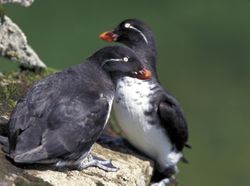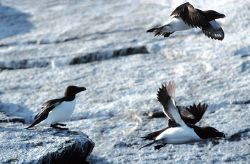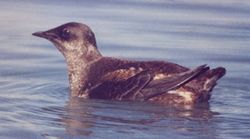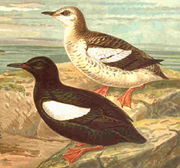|
Auks |

Parakeet Auklets
|
|
Scientific classification |
| Kingdom: |
Animalia
|
| Phylum: |
Chordata
|
| Class: |
Aves
|
| Order: |
Charadriiformes
|
| Family: |
Alcidae
Leach, 1820 |
|
|
Genera |
Uria
Alle
Alca
Pinguinus
Synthliboramphus
Cepphus
Brachyramphus
Ptychoramphus
Aethia
Cerorhinca
Fratercula
Extinct Genera, see
Systematics |
- This article is about a family of birds. For the
American ornithological journal, see
The Auk.
Auks are
birds of the family Alcidae in the order
Charadriiformes. They are superficially similar to
penguins due to their black-and-white colours, their
upright posture and some of their habits. Nevertheless they
are not related to the penguins at all, but considered by
some to be a product of moderate
convergent evolution.
In contrast to penguins, the modern auks are able to fly
(with the exception of the recently extinct
Great Auk). They are good swimmers and divers, but their
walking appears clumsy. Due to their short wings auks have
to flap their wings very fast in order to fly.
Auks live on the open sea and only go ashore for
breeding, although some species, like the
Common Guillemot, spend a great part of the year
defending their nesting spot from others.
Several species have different names in
Europe and North America. The guillemots of Europe are murres in
North America, if they occur in both continents, and the
Little Auk becomes the Dovekie.
Some species, such as the Uria guillemots, nest in large
colonies on cliff edges; others, like the
Cepphus guillemots, breed in small groups on rocky
coasts; and the
puffins, auklets and some murrelets nest in burrows. All
species except the
Brachyramphus murrelets are colonial.
Evolution and distribution
Traditionally, the auks were believed to be one of the
earliest distinct charadriiform lineages due to their
characteristic morphology. However, molecular analyses have
demonstrated that these peculiarities are the product of
strong natural selection instead: as opposed to, for
example, plovers (a much older charadriiform lineage), auks
radically changed from a wading shorebird to a diving
seabird lifestyle. Thus, today, the auks are no longer
separated in their own suborder ("Alcae"), but are
considered part of the Lari suborder which otherwise
contains gulls and similar birds. Judging from molecular
data, their closest living relatives appear to be the skuas,
with these two lineages separating about 30 MYA (Paton et
al., 2003). This may or may not be correct due to
uncertainties of the fossil record (Thomas et al., 2004, and
see below). Alternatively, auks may have split off far
earlier from the rest of the Lari and undergone strong
morphological, but slow molecular evolution, which would
require a very high evolutionary pressure, coupled with a long lifespan and
slow reproduction.
The earliest unequivocal fossils of auks are from the
Miocene (e.g. the genus Miocepphus, 15 MYA). Two very
fragmentary fossils are often assigned to the Alcidae,
although this may not be correct: Hydrotherikornis (Late
Eocene, some 35 MYA) and Petralca (Late Oligocene). Most
extant genera are known to exist since the Late Miocene or
Early Pliocene (c. 5 MYA). Miocene fossils have been found
in both California and Maryland, but the greater diversity
of fossils and tribes in the Pacific leads most scientists
to conclude that it was there they first evolved, and it is
in the Miocene Pacific that the first fossils of extant
genera are found. Early movement between the Pacific and the
Atlantic probably happened to the south (since there was no
northern opening to the Atlantic), later movements across
the Arctic Sea (Konyukhov, 2002). The flightless subfamily
Mancallinae which was apparently restricted to the Pacific
coast of southern North America became extinct in the Early
Pleistocene.
The extant auks (subfamily Alcinae) are broken up into 2
main groups: the usually high-billed puffins (tribe
Fraterculini) and auklets (tribe Aethiini), and the more
slender-billed murres (tribe Alcini) and the murrelets and
guillemots (tribes Brachyramphini and Cepphini). Molecular
studies (Friesen et al., 1996; Moum et al.,
2002) confirm this arrangement except that the
Synthliboramphus murrelets should be split into a
distinct tribe, as they appear more closely related to the
Alcini.
Compared to other families of seabirds, there are no
genera with many
species (such as the 47
Larus
gulls). This is probably a product of the rather small
geographic range of the family (the most limited of any
seabird family), and the periods of
glacial advance and retreat that have kept the
populations on the move in a narrow band of subarctic ocean.

Razorbills are only found in the Atlantic Ocean
Today, as in the past, the auks are restricted to cooler
northern waters. Their ability to spread further south is
restricted as their prey hunting method, pursuit diving,
becomes less efficient in warmer waters. The speed at which
small fish (which along with krill are the auk's principal
food items) can swim doubles as the temperature increases
from 5°C to 15°C, with no corresponding increase in speed
for the bird. The southernmost auks, in California and
Mexico, can survive there because of cold upwellings. The
current paucity of auks in the Atlantic (6 species),
compared to the Pacific (19-20 species) is considered to be
because of extinctions to the Atlantic auks; the fossil
record shows there were many more species in the Atlantic
during the Pliocene. Auks also tend to be restricted to
continental shelf waters and breed on few oceanic islands.
Feeding and ecology
The feeding behaviour of auks is often compared to that
of
penguins; they are both
wing-propelled pursuit divers. In the region where auks
live their only seabird competition is with
cormorants (which dive powered by their strong feet); in
areas where the two groups feed on the same prey the auks
tend to feed further offshore.
Although not to the extent of penguins, auks have to a
large extent sacrificed flight, and also mobility on land,
in exchange for swimming; their wings are a compromise
between the best possible design for diving and the bare
minimum needed for flying. This varies by subfamily, the
Uria guillemots (including the
Razorbill) and murrelets being the most efficient under
the water, whereas the puffins and auklets are better
adapted for flying and walking. This reflects the type of
prey taken; murres hunt faster schooling fish, whereas
auklets take slower moving krill. Time depth recorders on
auks have shown that they can dive as deep as 100 m in the
case of Uria guillemots, 40 m for the Cepphus
guillemots and between 30 m for the auklets.
Social behaviour and breeding

Marbled Murrelets breed singly and have brown
breed plumage to blend into their nesting sites.
The majority of auk species are
colonial, nesting in anything between small groups to large
thousand strong colonies. As well as possible advantages for
defence against predators, there is a benefit in terms of
foraging to being colonial; birds that see a neighbour
returning with food will set off to forage in the direction
it came from. Two species, the Marbled Murrelet and the
Kittlitz's Murrelet are solitary nesters, choosing old
growth forest and high mountains respectively. In these
areas the benefits of colonial nesting would be outweighed
by the presence of terrestrial predators (foxes and
raccoons, for example) which island and cliff breeding
auks do not have to deal with.
Nesting sites in colonies can vary from nothing more than
a patch on a cliff face, to natural crevices in the rocks
and boulders, to burrows dug by the bird. Many nesting sites
are attended nocturnally, in some cases as the adults are
likely to fall victim to kleptoparasitism (such as the
Rhinoceros Auklet) or because the adults themselves are
likely prey items (like the Cassin's Auklet). Mating itself
can happen both on the colony, as happens with the Razorbill
and Little Auk, or at sea, as is the case for
puffins and auklets.
Systematics

Common (centre) and Brunnich's Guillemots

Black Guillemot in summer and winter
plumages
ORDER
CHARADRIIFORMES
Suborder
Lari
Family Alcidae
-
Hydrotherikornis (fossil,
disputed)
- Subfamily Petralcinae (fossil,
disputed)
- Subfamily Alcinae
-
Miocepphus (fossil)
- Tribe Alcini - Auks and murres
-
Uria
-
Common Guillemot or Common Murre,
Uria aalge
-
Brunnich's Guillemot or Thick-billed
Murre, Uria lomvia
-
Little Auk or Dovekie, Alle alle
-
Great Auk, Pinguinus impennis (extinct,
c.1844)
-
Razorbill, Alca torda
- Tribe Synthliboramphini -
Synthliboramphine murrelets
-
Synthliboramphus
-
Xantus's Murrelet, Synthliboramphus
hypoleucus - sometimes separated in
Endomychura
-
Craveri's Murrelet, Synthliboramphus
craveri - sometimes separated in
Endomychura
-
Ancient Murrelet, Synthliboramphus
antiquus
-
Japanese Murrelet, Synthliboramphus
wumizusume
- Tribe Cepphini - True guillemots
-
Cepphus
-
Black Guillemot or Tystie, Cepphus
grylle
-
Pigeon Guillemot, Cepphus columba
-
Kurile Guillemot, Cepphus
(columba) snowi
-
Spectacled Guillemot, Cepphus carbo
- Tribe Brachyramphini - Brachyramphine
murrelets
-
Brachyramphus
-
Marbled Murrelet, Brachyramphus
marmoratus
-
Long-billed Murrelet
Brachyramphus (marmoratus) perdix
-
Kittlitz's Murrelet, Brachyramphus
brevirostris
- Tribe Aethiini - Auklets
-
Cassin's Auklet, Ptychoramphus aleuticus
-
Aethia
-
Parakeet Auklet, Aethia psittacula
-
Crested Auklet, Aethia cristatella
-
Whiskered Auklet, Aethia pygmaea
-
Least Auklet, Aethia pusilla
- Tribe Fraterculini - Puffins
-
Rhinoceros Auklet, Cerorhinca monocerata
-
Fratercula
-
Atlantic Puffin, Fratercula arctica
-
Horned Puffin, Fratercula corniculata
-
Tufted Puffin, Fratercula cirrhata
Biodiversity of auks seems to have been markedly higher
during the
Pliocene (Konyukhov, 2002). See the genus accounts for
prehistoric species.
References
- Collinson, Martin (2006): Splitting
headaches? Recent taxonomic changes affecting the
British and Western Palaearctic lists.
Brit. Birds 99(6): 306-323.
HTML abstract
- Friesen, V. L.; Baker, A. J. & Piatt, J. F.
(1996): Phylogenetic Relationships Within the Alcidae
(Charadriiformes: Aves) Inferred from Total Molecular
Evidence. Molecular Biology and Evolution 13(2):
359-367.
PDF fulltext
- Gaston, Anthony & Jones, Ian (1998):
The Auks, Alcidae. Oxford University Press,
Oxford.
ISBN 0-19-854032-9
- Konyukhov, N. B. (2002): Possible Ways of
Spreading and Evolution of Alcids. Izvestiya Akademii
Nauk, Seriya Biologicheskaya 5: 552–560
[Russian version]; Biology Bulletin 29(5):
447–454 [English version].
DOI:10.1023/A:1020457508769
(Biology Bulletin HTML abstract)
- Moum, Truls; Arnason, Ulfur & Árnason, Einar
(2002): Mitochondrial DNA Sequence Evolution and
Phylogeny of the Atlantic Alcidae, Including the Extinct
Great Auk (Pinguinus impennis). Molecular
Biology and Evolution 19(9): 1434–1439.
PDF fulltext
- Paton, T. A.; Baker, A. J.; Groth, J. G. &
Barrowclough, G. F. (2003): RAG-1 sequences resolve
phylogenetic relationships within charadriiform birds.
Molecular Phylogenetics and Evolution 29:
268-278.
DOI:10.1016/S1055-7903(03)00098-8
(HTML abstract)




